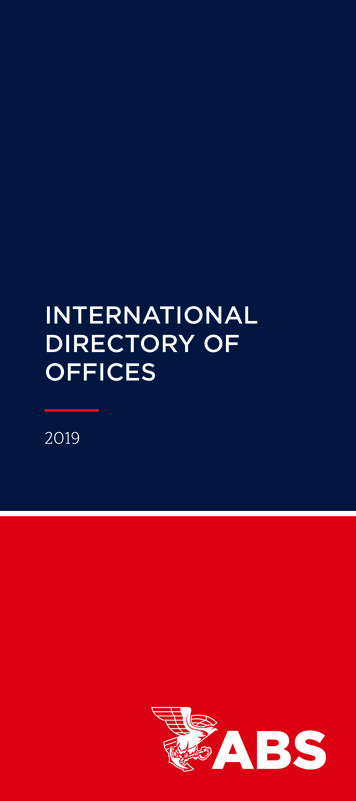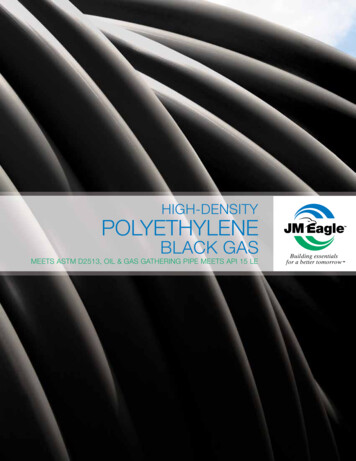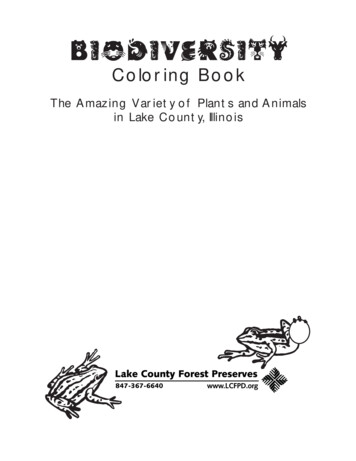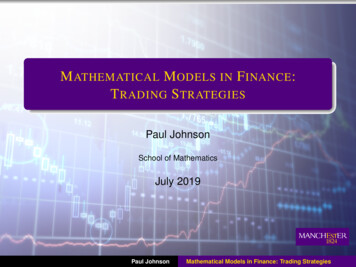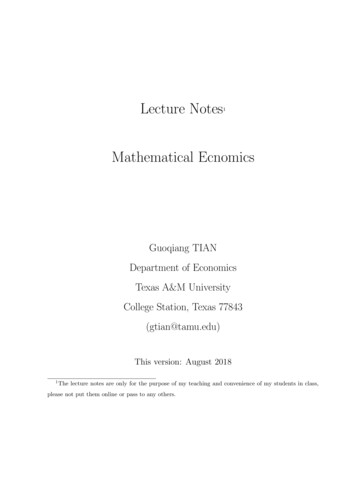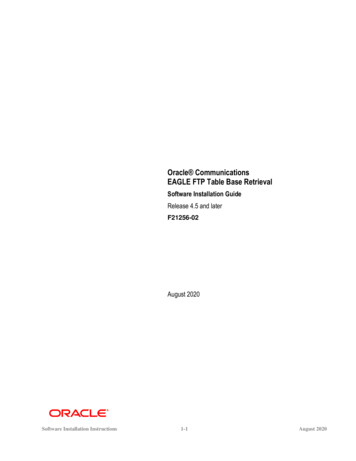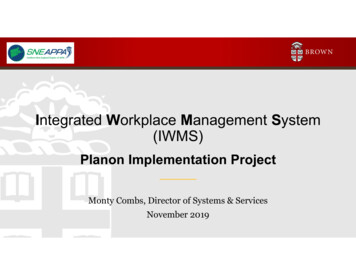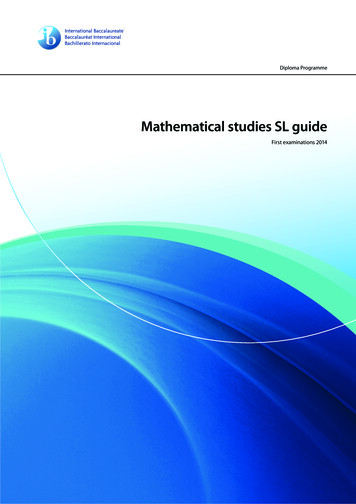
Transcription
Diploma ProgrammeMathematical studies SL guideFirst examinations 2014
Diploma ProgrammeMathematical studies SL guideFirst examinations 2014
Diploma ProgrammeMathematical studies SL guidePublished March 2012Published on behalf of the International Baccalaureate Organization, a not-for-profiteducational foundation of 15 Route des Morillons, 1218 Le Grand-Saconnex, Geneva,Switzerland by theInternational Baccalaureate Organization (UK) LtdPeterson House, Malthouse Avenue, Cardiff GateCardiff, Wales CF23 8GLUnited KingdomPhone: 44 29 2054 7777Fax: 44 29 2054 7778Website: www.ibo.org International Baccalaureate Organization 2012The International Baccalaureate Organization (known as the IB) offers three high-qualityand challenging educational programmes for a worldwide community of schools, aimingto create a better, more peaceful world. This publication is one of a range of materialsproduced to support these programmes.The IB may use a variety of sources in its work and checks information to verify accuracyand authenticity, particularly when using community-based knowledge sources such asWikipedia. The IB respects the principles of intellectual property and makes strenuousefforts to identify and obtain permission before publication from rights holders of allcopyright material used. The IB is grateful for permissions received for material usedin this publication and will be pleased to correct any errors or omissions at the earliestopportunity.All rights reserved. No part of this publication may be reproduced, stored in a retrievalsystem, or transmitted, in any form or by any means, without the prior written permissionof the IB, or as expressly permitted by law or by the IB’s own rules and policy. Seehttp://www.ibo.org/copyright.I B me rcha nd ise a nd publ icat ion s ca n be pu rcha sed t h roug h t he I B store athttp://store.ibo.org. General ordering queries should be directed to the Sales and MarketingDepartment in Cardiff.Phone: 44 29 2054 7746Fax: 44 29 2054 7779Email: sales@ibo.orgInternational Baccalaureate, Baccalauréat International and Bachillerato Internacional areregistered trademarks of the International Baccalaureate Organization.Printed in the United Kingdom by Antony Rowe Ltd, Chippenham, Wiltshire5030
IB mission statementThe International Baccalaureate aims to develop inquiring, knowledgeable and caring young people who help tocreate a better and more peaceful world through intercultural understanding and respect.To this end the organization works with schools, governments and international organizations to develop challengingprogrammes of international education and rigorous assessment.These programmes encourage students across the world to become active, compassionate and lifelong learners whounderstand that other people, with their differences, can also be right.IB learner profileThe aim of all IB programmes is to develop internationally minded people who, recognizing their common humanityand shared guardianship of the planet, help to create a better and more peaceful world.IB learners strive to be:InquirersThey develop their natural curiosity. They acquire the skills necessary to conduct inquiryand research and show independence in learning. They actively enjoy learning and this loveof learning will be sustained throughout their lives.KnowledgeableThey explore concepts, ideas and issues that have local and global significance. In so doing,they acquire in-depth knowledge and develop understanding across a broad and balancedrange of disciplines.ThinkersThey exercise initiative in applying thinking skills critically and creatively to recognizeand approach complex problems, and make reasoned, ethical decisions.CommunicatorsThey understand and express ideas and information confidently and creatively in morethan one language and in a variety of modes of communication. They work effectively andwillingly in collaboration with others.PrincipledThey act with integrity and honesty, with a strong sense of fairness, justice and respect forthe dignity of the individual, groups and communities. They take responsibility for theirown actions and the consequences that accompany them.Open-mindedThey understand and appreciate their own cultures and personal histories, and are opento the perspectives, values and traditions of other individuals and communities. They areaccustomed to seeking and evaluating a range of points of view, and are willing to growfrom the experience.CaringThey show empathy, compassion and respect towards the needs and feelings of others.They have a personal commitment to service, and act to make a positive difference to thelives of others and to the environment.Risk-takersThey approach unfamiliar situations and uncertainty with courage and forethought, andhave the independence of spirit to explore new roles, ideas and strategies. They are braveand articulate in defending their beliefs.BalancedThey understand the importance of intellectual, physical and emotional balance to achievepersonal well-being for themselves and others.ReflectiveThey give thoughtful consideration to their own learning and experience. They are able toassess and understand their strengths and limitations in order to support their learning andpersonal development. International Baccalaureate Organization 2007
ContentsIntroduction 1Purpose of this document 1The Diploma Programme 2Nature of the subject 4Aims 8Assessment objectives 9Syllabus 10Syllabus outline 10Approaches to the teaching and learning of mathematical studies SL 11Prior learning topics 14Syllabus content 16Assessment 35Assessment in the Diploma Programme 35Assessment outline 37External assessment 38Internal assessment 40Appendices 50Glossary of command terms 50Notation list 52Mathematical studies SL guide
IntroductionPurpose of this documentThis publication is intended to guide the planning, teaching and assessment of the subject in schools. Subjectteachers are the primary audience, although it is expected that teachers will use the guide to inform studentsand parents about the subject.This guide can be found on the subject page of the online curriculum centre (OCC) at http://occ.ibo.org, apassword-protected IB website designed to support IB teachers. It can also be purchased from the IB store athttp://store.ibo.org.Additional resourcesAdditional publications such as teacher support materials, subject reports, internal assessment guidanceand grade descriptors can also be found on the OCC. Specimen and past examination papers as well asmarkschemes can be purchased from the IB store.Teachers are encouraged to check the OCC for additional resources created or used by other teachers. Teacherscan provide details of useful resources, for example: websites, books, videos, journals or teaching ideas.AcknowledgmentThe IB wishes to thank the educators and associated schools for generously contributing time and resources tothe production of this guide.First examinations 2014Mathematical studies SL guide1
IntroductionThe Diploma ProgrammeThe Diploma Programme is a rigorous pre-university course of study designed for students in the 16 to 19age range. It is a broad-based two-year course that aims to encourage students to be knowledgeable andinquiring, but also caring and compassionate. There is a strong emphasis on encouraging students to developintercultural understanding, open-mindedness, and the attitudes necessary for them to respect and evaluate arange of points of view.The Diploma Programme hexagonThe course is presented as six academic areas enclosing a central core (see figure 1). It encourages the concurrentstudy of a broad range of academic areas. Students study: two modern languages (or a modern language anda classical language); a humanities or social science subject; an experimental science; mathematics; one ofthe creative arts. It is this comprehensive range of subjects that makes the Diploma Programme a demandingcourse of study designed to prepare students effectively for university entrance. In each of the academic areasstudents have flexibility in making their choices, which means they can choose subjects that particularlyinterest them and that they may wish to study further at university.Studies in languageand literatureGroup 1Group 2Group 3Individualsand societiesessayedndPR sitionEExperimentalsciencesGroup 4creaicetivity, action, servGroup 5MathematicsGroup 6The artsFigure 1Diploma Programme model2Mathematical studies SL guide
The Diploma ProgrammeChoosing the right combinationStudents are required to choose one subject from each of the six academic areas, although they can choose asecond subject from groups 1 to 5 instead of a group 6 subject. Normally, three subjects (and not more thanfour) are taken at higher level (HL), and the others are taken at standard level (SL). The IB recommends 240teaching hours for HL subjects and 150 hours for SL. Subjects at HL are studied in greater depth and breadththan at SL.At both levels, many skills are developed, especially those of critical thinking and analysis. At the end of thecourse, students’ abilities are measured by means of external assessment. Many subjects contain some elementof coursework assessed by teachers. The course is available for examinations in English, French and Spanish,with the exception of groups 1 and 2 courses where examinations are in the language of study.The core of the hexagonAll Diploma Programme students participate in the three course requirements that make up the core of thehexagon. Reflection on all these activities is a principle that lies at the heart of the thinking behind the DiplomaProgramme.The theory of knowledge course encourages students to think about the nature of knowledge, to reflect onthe process of learning in all the subjects they study as part of their Diploma Programme course, and to makeconnections across the academic areas. The extended essay, a substantial piece of writing of up to 4,000 words,enables students to investigate a topic of special interest that they have chosen themselves. It also encouragesthem to develop the skills of independent research that will be expected at university. Creativity, action, serviceinvolves students in experiential learning through a range of artistic, sporting, physical and service activities.The IB mission statement and the IB learner profileThe Diploma Programme aims to develop in students the knowledge, skills and attitudes they will need tofulfill the aims of the IB, as expressed in the organization’s mission statement and the learner profile. Teachingand learning in the Diploma Programme represent the reality in daily practice of the organization’s educationalphilosophy.Mathematical studies SL guide3
IntroductionNature of the subjectIntroductionThe nature of mathematics can be summarized in a number of ways: for example, it can be seen as a welldefined body of knowledge, as an abstract system of ideas, or as a useful tool. For many people it is probablya combination of these, but there is no doubt that mathematical knowledge provides an important key tounderstanding the world in which we live. Mathematics can enter our lives in a number of ways: we buyproduce in the market, consult a timetable, read a newspaper, time a process or estimate a length. Mathematics,for most of us, also extends into our chosen profession: visual artists need to learn about perspective; musiciansneed to appreciate the mathematical relationships within and between different rhythms; economists needto recognize trends in financial dealings; and engineers need to take account of stress patterns in physicalmaterials. Scientists view mathematics as a language that is central to our understanding of events that occurin the natural world. Some people enjoy the challenges offered by the logical methods of mathematics andthe adventure in reason that mathematical proof has to offer. Others appreciate mathematics as an aestheticexperience or even as a cornerstone of philosophy. This prevalence of mathematics in our lives, with all itsinterdisciplinary connections, provides a clear and sufficient rationale for making the study of this subjectcompulsory for students studying the full diploma.Summary of courses availableBecause individual students have different needs, interests and abilities, there are four different courses inmathematics. These courses are designed for different types of students: those who wish to study mathematicsin depth, either as a subject in its own right or to pursue their interests in areas related to mathematics; thosewho wish to gain a degree of understanding and competence to understand better their approach to othersubjects; and those who may not as yet be aware how mathematics may be relevant to their studies and in theirdaily lives. Each course is designed to meet the needs of a particular group of students. Therefore, great careshould be taken to select the course that is most appropriate for an individual student.In making this selection, individual students should be advised to take account of the following factors: their own abilities in mathematics and the type of mathematics in which they can be successful their own interest in mathematics and those particular areas of the subject that may hold the most interestfor them their other choices of subjects within the framework of the Diploma Programme their academic plans, in particular the subjects they wish to study in future their choice of career.Teachers are expected to assist with the selection process and to offer advice to students.Mathematical studies SLThis course is available only at standard level, and is equivalent in status to mathematics SL, but addressesdifferent needs. It has an emphasis on applications of mathematics, and the largest section is on statisticaltechniques. It is designed for students with varied mathematical backgrounds and abilities. It offers students4Mathematical studies SL guide
Nature of the subjectopportunities to learn important concepts and techniques and to gain an understanding of a wide varietyof mathematical topics. It prepares students to be able to solve problems in a variety of settings, to developmore sophisticated mathematical reasoning and to enhance their critical thinking. The individual project is anextended piece of work based on personal research involving the collection, analysis and evaluation of data.Students taking this course are well prepared for a career in social sciences, humanities, languages or arts.These students may need to utilize the statistics and logical reasoning that they have learned as part of themathematical studies SL course in their future studies.Mathematics SLThis course caters for students who already possess knowledge of basic mathematical concepts, and who areequipped with the skills needed to apply simple mathematical techniques correctly. The majority of thesestudents will expect to need a sound mathematical background as they prepare for future studies in subjectssuch as chemistry, economics, psychology and business administration.Mathematics HLThis course caters for students with a good background in mathematics who are competent in a range ofanalytical and technical skills. The majority of these students will be expecting to include mathematics asa major component of their university studies, either as a subject in its own right or within courses such asphysics, engineering and technology. Others may take this subject because they have a strong interest inmathematics and enjoy meeting its challenges and engaging with its problems.Further mathematics HLThis course is available only at higher level. It caters for students with a very strong background in mathematicswho have attained a high degree of competence in a range of analytical and technical skills, and who displayconsiderable interest in the subject. Most of these students will expect to study mathematics at university, eitheras a subject in its own right or as a major component of a related subject. The course is designed specificallyto allow students to learn about a variety of branches of mathematics in depth and also to appreciate practicalapplications. It is expected that students taking this course will also be taking mathematics HL.Note: Mathematics HL is an ideal course for students expecting to include mathematics as a major componentof their university studies, either as a subject in its own right or within courses such as physics, engineeringor technology. It should not be regarded as necessary for such students to study further mathematics HL.Rather, further mathematics HL is an optional course for students with a particular aptitude and interest inmathematics, enabling them to study some wider and deeper aspects of mathematics, but is by no means anecessary qualification to study for a degree in mathematics.Mathematical studies SL—course detailsThe course syllabus focuses on important mathematical topics that are interconnected. The syllabus isorganized and structured with the following tenets in mind: placing more emphasis on student understandingof fundamental concepts than on symbolic manipulation and complex manipulative skills; giving greateremphasis to developing students’ mathematical reasoning rather than performing routine operations; solvingmathematical problems embedded in a wide range of contexts; using the calculator effectively.The course includes project work, a feature unique to mathematical studies SL within group 5. Eachstudent completes a project, based on their own research; this is guided and supervised by the teacher. Theproject provides an opportunity for students to carry out a mathematical study of their choice using theirown experience, knowledge and skills acquired during the course. This process allows students to take soleresponsibility for a part of their studies in mathematics.Mathematical studies SL guide5
Nature of the subjectThe students most likely to select this course are those whose main interests lie outside the field of mathematics,and for many students this course will be their final experience of being taught formal mathematics. Allparts of the syllabus have therefore been carefully selected to ensure that an approach starting from firstprinciples can be used. As a consequence, students can use their own inherent, logical thinking skills and donot need to rely on standard algorithms and remembered formulae. Students likely to need mathematics for theachievement of further qualifications should be advised to consider an alternative mathematics course.Owing to the nature of mathematical studies SL, teachers may find that traditional methods of teaching areinappropriate and that less formal, shared learning techniques can be more stimulating and rewarding forstudents. Lessons that use an inquiry-based approach, starting with practical investigations where possible,followed by analysis of results, leading to the understanding of a mathematical principle and its formulationinto mathematical language, are often most successful in engaging the interest of students. Furthermore, thistype of approach is likely to assist students in their understanding of mathematics by providing a meaningfulcontext and by leading them to understand more fully how to structure their work for the project.Prior learningMathematics is a linear subject, and it is expected that most students embarking on a Diploma Programme(DP) mathematics course will have studied mathematics for at least 10 years. There will be a great variety oftopics studied, and differing approaches to teaching and learning. Thus, students will have a wide variety ofskills and knowledge when they start the mathematical studies SL course. Most will have some background inarithmetic, algebra, geometry, trigonometry, probability and statistics. Some will be familiar with an inquiryapproach, and may have had an opportunity to complete an extended piece of work in mathematics.At the beginning of the syllabus section there is a list of topics that are considered to be prior learning forthe mathematical studies SL course. It is recognized that this may contain topics that are unfamiliar to somestudents, but it is anticipated that there may be other topics in the syllabus itself that these students havealready encountered. Teachers should plan their teaching to incorporate topics mentioned that are unfamiliarto their students.Links to the Middle Years ProgrammeThe prior learning topics for the DP courses have been written in conjunction with the Middle YearsProgramme (MYP) mathematics guide. The approaches to teaching and learning for DP mathematics buildon the approaches used in the MYP. These include investigations, exploration and a variety of differentassessment tools.A continuum document called Mathematics: The MYP–DP continuum (November 2010) is available on theDP mathematics home pages of the online curriculum centre (OCC). This extensive publication focuses on thealignment of mathematics across the MYP and the DP. It was developed in response to feedback provided byIB World Schools, which expressed the need to articulate the transition of mathematics from the MYP to theDP. The publication also highlights the similarities and differences between MYP and DP mathematics, and isa valuable resource for teachers.Mathematics and theory of knowledgeThe Theory of knowledge guide (March 2006) identifies four ways of knowing, and it could be claimed thatthese all have some role in the acquisition of mathematical knowledge. While perhaps initially inspired by datafrom sense perception, mathematics is dominated by reason, and some mathematicians argue that their subject6Mathematical studies SL guide
Nature of the subjectis a language, that it is, in some sense, universal. However, there is also no doubt that mathematicians perceivebeauty in mathematics, and that emotion can be a strong driver in the search for mathematical knowledge.As an area of knowledge, mathematics seems to supply a certainty perhaps missing in other disciplines. Thismay be related to the “purity” of the subject that makes it sometimes seem divorced from reality. However,mathematics has also provided important knowledge about the world, and the use of mathematics in scienceand technology has been one of the driving forces for scientific advances.Despite all its undoubted power for understanding and change, mathematics is in the end a puzzlingphenomenon. A fundamental question for all knowers is whether mathematical knowledge really existsindependently of our thinking about it. Is it there “waiting to be discovered” or is it a human creation?Students’ attention should be drawn to questions relating theory of knowledge (TOK) and mathematics, andthey should be encouraged to raise such questions themselves, in mathematics and TOK classes. This includesquestioning all the claims made above! Examples of issues relating to TOK are given in the “Links” column ofthe syllabus. Teachers could also discuss questions such as those raised in the “Areas of knowledge” section ofthe Theory of knowledge guide.Mathematics and the international dimensionMathematics is in a sense an international language, and, apart from slightly differing notation, mathematiciansfrom around the world can communicate within their field. Mathematics transcends politics, religion andnationality, yet throughout history great civilizations owe their success in part to their mathematicians beingable to create and maintain complex social and architectural structures.Despite recent advances in the development of information and communication technologies, the globalexchange of mathematical information and ideas is not a new phenomenon and has been essential to theprogress of mathematics. Indeed, many of the foundations of modern mathematics were laid many centuriesago by Arabic, Greek, Indian and Chinese civilizations, among others. Teachers could use timeline websitesto show the contributions of different civilizations to mathematics, but not just for their mathematical content.Illustrating the characters and personalities of the mathematicians concerned and the historical context inwhich they worked brings home the human and cultural dimension of mathematics.The importance of science and technology in the everyday world is clear, but the vital role of mathematicsis not so well recognized. It is the language of science, and underpins most developments in science andtechnology. A good example of this is the digital revolution, which is transforming the world, as it is all basedon the binary number system in mathematics.Many international bodies now exist to promote mathematics. Students are encouraged to access the extensivewebsites of international mathematical organizations to enhance their appreciation of the internationaldimension and to engage in the global issues surrounding the subject.Examples of global issues relating to international-mindedness (Int) are given in the “Links” column of thesyllabus.Mathematical studies SL guide7
IntroductionAimsGroup 5 aimsThe aims of all mathematics courses in group 5 are to enable students to:1.enjoy mathematics, and develop an appreciation of the elegance and power of mathematics2.develop an understanding of the principles and nature of mathematics3.communicate clearly and confidently in a variety of contexts4.develop logical, critical and creative thinking, and patience and persistence in problem-solving5.employ and refine their powers of abstraction and generalization6.apply and transfer skills to alternative situations, to other areas of knowledge and to future developments7.appreciate how developments in technology and mathematics have influenced each other8.appreciate the moral, social and ethical implications arising from the work of mathematicians and theapplications of mathematics9.appreciate the international dimension in mathematics through an awareness of the universality ofmathematics and its multicultural and historical perspectives10.appreciate the contribution of mathematics to other disciplines, and as a particular “area of knowledge”in the TOK course.8Mathematical studies SL guide
IntroductionAssessment objectivesProblem-solving is central to learning mathematics and involves the acquisition of mathematical skills andconcepts in a wide range of situations, including non-routine, open-ended and real-world problems. Havingfollowed a DP mathematical studies SL course, students will be expected to demonstrate the following.1.Knowledge and understanding: recall, select and use their knowledge of mathematical facts, conceptsand techniques in a variety of familiar and unfamiliar contexts.2.Problem-solving: recall, select and use their knowledge of mathematical skills, results and models inboth real and abstract contexts to solve problems.3.Communication and interpretation: transform common realistic contexts into mathematics; commenton the context; sketch or draw mathematical diagrams, graphs or constructions both on paper and usingtechnology; record methods, solutions and conclusions using standardized notation.4.Technology: use technology, accurately, appropriately and efficiently both to explore new ideas and tosolve problems.5.Reasoning: construct mathematical arguments through use of precise statements, logical deduction andinference, and by the manipulation of mathematical expressions.6.Investigative approaches: investigate unfamiliar situations involving organizing and analysinginformation or measurements, drawing conclusions, testing their validity, and considering their scopeand limitations.Mathematical studies SL guide9
SyllabusSyllabus outlineTeachinghoursSyllabus componentSLAll topics are compulsory. Students must study all the sub-topics in each of the topics in thesyllabus as listed in this guide. Students are also required to be familiar with the topics listedas prior learning.Topic 120Number and algebraTopic 212Descriptive statisticsTopic 320Logic, sets and probabilityTopic 417Statistical applicationsTopic 518Geometry and trigonometryTopic 620Mathematical modelsTopic 718Introduction to differential calculusProject25The project is an individual piece of work involving the collection of information orthe generation of measurements, and the analysis and evaluation of the information ormeasurements.Total teaching hours150It is essential that teachers are allowed the prescribed minimum number of teaching hours necessary to meetthe requirements of the mathematical studies SL course. At SL the minimum prescribed number of hours is150 hours.10Mathematical studies SL guide
SyllabusApproaches to the teaching and learningof mathematical studies SLIn this course the students will have the opportunity to understand and appreciate both the practical use ofmathematics and its aesthetic aspects. They will be encouraged to build on knowledge from prior learningin mathematics and other subjects, as well as their own experience. It is important that students developmathematical intuition and understand how they can apply mathematics in life.Teaching needs to be flexible and to allow for different styles of learning. There is a diverse range of studentsin a mathematical studies SL classroom, and visual, auditory and kinaesthetic approaches to teaching may givenew insights. The use of technology, particularly the graphic display calculator (GDC) and computer packages,can be very useful in allowing students to explore ideas in a rich context. It is left to the individual teacher todecide the order in which the separate topics are presented, but teaching and learning activities should weavethe parts of the syllabus together and focus on their interrelationships. For example, the connection betweengeometric sequences and exponential functions can be illustrated by the consideration of compound interest.Teachers may wish to introduce some topics using hand
four) are taken at higher level (HL), and the others are taken at standard level (SL). The IB recommends 240 teaching hours for HL subjects and 150 hours for SL. Subjects at HL are studied in greater depth and breadth . Mathematics can enter our lives in a number of ways: we buy produce

